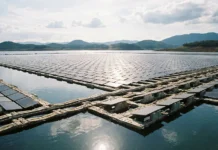Percheron Power of Kennewick hopes to build a small conduit project on a canal two miles west of Mesa near Road 170 and Langford Road.
The Franklin County Planning Commission unanimously recommended approval for the conditional use permit for the project Tuesday, but the company has many other regulatory hoops to jump through before construction.
Percheron Power received a $1.5 million federal grant from the Department of Energy and Department of the Interior’s Bureau of Reclamation in September to install the nation’s first Archimedes Hydrodynamic Screw hydropower system in the Potholes East Canal.
That will help pay for the $5 million system that will harness the energy produced in the 18-foot drop at the current check station in the canal, said Sharon Atkin, Percheron Power project development director.
“Right now, that energy is just going kind of down the drain, and it can be captured,” said Jerry Straalsund, the company’s president.
There will be no change to the water level in the canal, and Straalsund said the electric project will not affect irrigators.
The project would use four turbines in which water would flow through at 30 to 50 revolutions per minute, Straalsund said. The technology already has been used in Europe for about 15 years.
The water will be brought around the existing check station in the Potholes East Canal and into the turbines using a bypass channel and will then return to the canal after the station, according to documents.
Operators’ quarters also would need to be on site for periods when intense oversight would be needed, Straalsund said.¬ÝThe energy will be transferred to the Big Bend Electric Co-op grid, and sold to whoever wants the power, Atkin said. It meets renewable energy requirements.
Once complete, the project will produce about 7,000 megawatt hours each year, or enough to power about 540 homes in the Northwest, according to documents.
Percheron Power has an exclusive option to buy 20 acres along the west side of the canal from Jay Wood of Othello, according to a Nov. 20 letter from Percheron Power. The land will remain in agricultural use until the hydroelectric project is constructed. Then, about three acres will be used for the project and about 15 will continue to be used for farming.
The existing canal system will continue to be operated by the Bureau of Reclamation and the South Columbia Basin Irrigation District.¬ÝMore than 100,000 acres of irrigated farmland are served downstream of the station on the Potholes East Canal, the South Columbia Basin Irrigation District said in county documents.
The system would run during the irrigation season, and Atkin said it may be possible to run one turbine during the off-season, since the canal does not dry up completely.¬ÝStraalsund and Atkin were involved in Green Energy Today, a Tri-City company that developed the Esquatzel hydroelectric project in Franklin County, but Straalsund said he sold his part of the company about a year ago. This project uses a different technology than the Green Energy Today project.
Franklin PUD started using energy from the Esquatzel project on Nov. 21, and has so far bought about 600 megawatt hours of power, said Debbie Bone-Harris, Franklin PUD spokeswoman.¬ÝThe public utility district has not been approached by Straalsund about the Percheron Power project, but Bone-Harris said the district supports small hydroelectric power projects and would take a hard look at buying power from the project if it was presented to them.
Franklin County commissioners will consider the conditional use permit after a 10-day appeal period.The project is expected to take three to five years to complete based on all of the regulatory requirements, according to a Nov. 30 letter from Percheron Power.¬ÝConstruction will take less than six months once all those requirements are met, Atkin said.
¬Ý









































